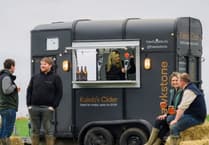Over the last two years, the Bantham Estate says it has been “working carefully” with a number of important consultee bodies to “conserve and manage” several important areas of the estate land.
Over July 30 and 31, heavy horses were used to roll the bracken on Bantham Ham as part of the management plan agreed with Natural England.
As well as being, hopefully, a lovely image of past meeting present in this special and much-loved beachside location, it is also an opportunity for a better understanding of some of the other aspects of the estate which sometimes do not get the attention they deserve or get reported inaccurately.
The Bantham Estate has now successfully entered the two Ham’s, Bantham and Cockleridge, and all its woodland into Natural England’s Higher Tier Environmental Stewardship schemes.
This was a crucial part of the environmental commitment made by the Bantham Estate, which led the discussion with Natural England, with advice from Historic England, to increase the conservation and ecology protection of the estate as a whole, rather than in a few isolated parts.
As part of that, the estate is looking to reclaim the eastern part of the Ham from invasive species such as bramble, bracken and blackthorn and to restore it to hay meadow and species-rich grassland.
In order to tackle the bracken problem the estate is bringing in heavy horses to roll the bracken so that they do not have to spray it with chemicals.
Under the higher tier countryside stewardship scheme, Bantham’s entire Ham will be protected under policies CT1 and GS7. CT1 is for ‘management of coastal sand dunes and vegetative shingle’. GS7 is for ‘restoration towards species-rich grassland’.
There is a new Countryside Stewardship environmental scheme being applied for on the Bigbury side of the estuary. This will coordinate with the existing organic scheme which covers most of the Bantham Estate land on that side of the River Avon.
A new 10 year Woodland Management scheme was entered into by Bantham Estate with the Forestry Commission and Natural England, with the first works under this scheme undertaken during the winter of 2017/2018.
Further gradually thinning and replanting works will be undertaken on an annual basis over the life of the 10 year woodland scheme.
A woodland grant has also been applied for under the current round of Natural England funding to plant a further 5.72 hectares (14.134 acres) of native mixed woodland - 93 per cent broadleaves and seven per cent conifers - split between two chosen areas on the estate.
Again, this element of the estate conservation plan was considered in conjuncture with Natural England, with whom the estate have regular and ongoing dialogue on a diversity of land management matters.
The estate supports the principal of the new Marine Conservation Zone on the River Avon estuary. The estate has full time resources available to best administer the wellbeing and sensible management of the River Avon.
The estate is regularly clearing rubbish and tidal debris from the river and has been helping press South West Water for a significant improvement in the overflow foul drainage system at Aveton Gifford.
The estate works carefully with the Aune Conservation Association and the Duchy of Cornwall with regard to all aspects of the administration of the tidal estuary and we believe that the potential for further proactive and considered management of the River Avon will be assisted by the MCZ designation, if awarded.
The estate is currently working with Natural England, the Duchy of Cornwall and various other bodies to address the upcoming requirements for the UK Coastal Path.
Natural England have stated its preferred solution is to see a much increased ferry service linking Bantham (from the ferry point beside Coronation boathouse) to Cockleridge Ham, thus making a more consistent connection between the Coastal Path at the closest point to the sea (the alternative arrangement being a longer, but equally enjoyable, hike inland on the River Avon Estuary Way).
Contrary to some suggestions, the estate was always very positive about the benefits of a well considered Neighbourhood Plan for the Thurlestone, Buckland and Bantham villages.
Whilst it is perfectly reasonable for the estate to seek further beneficial policies under the Neighbourhood Plan, the final approved version has a wide range of policy statements that are supportive to the Bantham Estate.
In particular, the estate will continue to pursue further employment opportunity led initiatives as we believe that a vibrant estate, with several active business elements, will offer a wider range of job opportunities to more local people in the years ahead, assisting the estate and the local community maintain a sustainable future.
It is now wildly known that the estate and Bigbury Golf Club are working together to produce a robust long term development and management plan for this historic golf club.
The estate regards Bigbury Golf Club as being an important constituent part of the estate and we are proactively working with the club to look at appropriate ways that we can properly safeguard and future proof this wonderful club, and its significant position within the local community, for a long period into the future.
Furthermore, it considers that there are a variety of other collaborative solutions that may be achieved by the estate working with local bodies and local organisations on both sides of the river to achieve similarly positive results.
So far as the particular work being done on the Bantham Ham over these two days, Ryan Hooper, the estate manager said: “Rolling bracken actually breaks and bruises the stem from which the plant does not recover. Simply cutting bracken does not work because it grows back.
“July and August are the best months to tackle bracken and because of the range of terrain that we have to deal with it has been decided that horses drawing rollers are probably going to be most effective and obviously we do not want to spray with chemicals.
“The long-term conservation plan has been worked on carefully for the last two years by the Bantham Estate team in partnership with Natural England and Historic England. It will protect dune areas and areas at the mouth the river, locking them into a sustainable project plan to conserve Bantham’s precious maritime dune system.
“The Bantham Estate, Natural England and Historic England believe that the estate is being sensibly managed for the benefit of the environment. The practical management of these options is complicated and challenging but over time we should see improvements which are measured in various ways including for example the proliferation of indicator species.
“One of the problems is that particular parts of the dune system and some surrounding area has become stabilised which means that the sand is no longer blowing around and the dunes are not shifting much.
“This has allowed organic matter to build up and consequently aggressive species like brambles, bracken and Blackthorn are getting a foothold and beginning to smother out the more specialised and delicate coastal sand dune species. These hard-growing plants produce strong roots which can also potentially damage archaeology too which can be another longer term concern.
“Over the last four years since the estate changed hands, there has been a greater emphasis on a holistic and longer term management plan, specifically for the management of all of our land, the Hams and the estuary.
“However, the discussions with bodies always take time and until you are accepted onto one of the schemes, you don’t really know where you stand. We haven’t been able to fully explain to people exactly what was happening because we were not yet accepted into the scheme, but now our new Higher Tier Stewardship application has been accepted we can be much more transparent with our management objectives in this regard.
“We have all always understood the special environmental nature of the beach and the estuary and as an estate team we all work hard to conserve these precious, and much loved, parts of the estate whilst also trying to provide for all our beachgoers and walkers who also appreciate the very special beauty and enjoyment that Bantham offers.
“I’m delighted that as an estate team we can now finally show off the plans we have for Bantham and the special natural environment here. It has been frustrating not to be able to give any definite answers to questions about the future of this amazing place until now and I can completely understand how some people may have been extremely anxious.
“However, now we have been accepted onto the new Stewardship scheme, I hope now that this will make our intentions for the future of this beautiful environment clear.
“We are hoping that as many people as possible come to our beach and see the interesting conservation work we are doing. There are paths around the dunes and footpaths up and down the river which you can access from our carpark, and of course there is the South West Coast path so people can come along and walk around this area and see what we are doing on the ground.”



